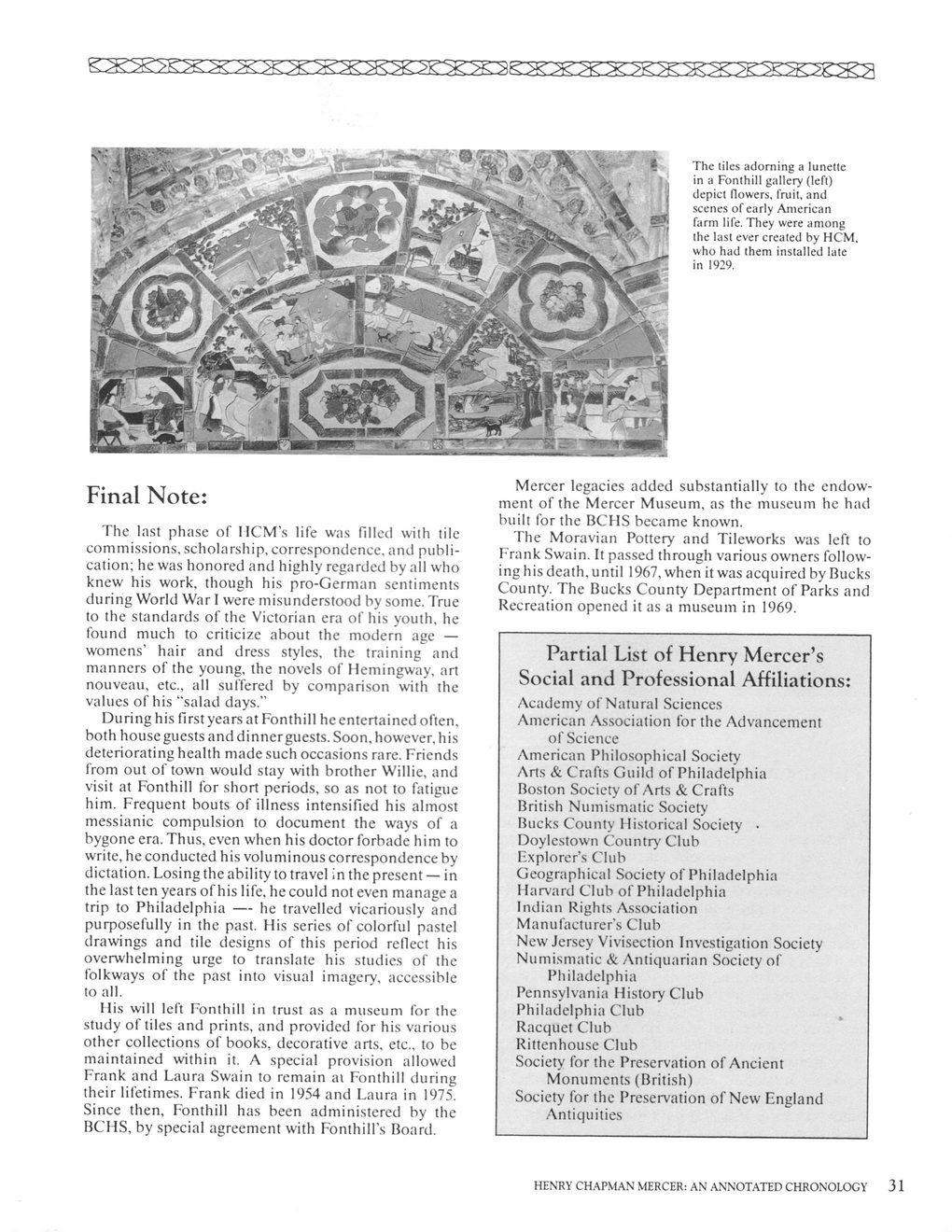This text was obtained via automated optical character recognition.
It has not been edited and may therefore contain several errors.
The tiles adorning a lunette in a Fonthill gallery (left) depict flowers, fruit, and scenes of early American farm life. They were among the last ever created by HCM, who had them installed late in 1929. Final Note: The last phase of HCM’s life was filled with tile commissions, scholarship, correspondence, and publication; he was honored and highly regarded by all who knew his work, though his pro-German sentiments during World War 1 were misunderstood by some. True to the standards of the Victorian era of his youth, he found much to criticize about the modern age — womens’ hair and dress styles, the training and manners of the young, the novels of Hemingway, art nouveau, etc., all suffered by comparison with the values of his “salad days.” During his first years at Fonthill he entertained often, both house guests and dinner guests. Soon, however, his deteriorating health made such occasions rare. Friends from out of town would stay with brother Willie, and visit at Fonthill for short periods, so as not to fatigue him. Frequent bouts of illness intensified his almost messianic compulsion to document the ways of a bygone era. Thus, even when his doctor forbade him to write, he conducted his voluminous correspondence by dictation. Losing the ability to travel in the present — in the last ten years of his life, he could not even manage a trip to Philadelphia — he travelled vicariously and purposefully in the past. His series of colorful pastel drawings and tile designs of this period reflect his overwhelming urge to translate his studies of the folkways of the past into visual imagery, accessible to all. His will left Fonthill in trust as a museum for the study of tiles and prints, and provided for his various other collections of books, decorative arts, etc., to be maintained within it. A special provision allowed Frank and Laura Swain to remain at Fonthill during their lifetimes. Frank died in 1954 and Laura in 1975. Since then, Fonthill has been administered by the BCHS, by special agreement with Fonthill’s Board. Mercer legacies added substantially to the endowment of the Mercer Museum, as the museum he had built for the BCHS became known. The Moravian Pottery and Tileworks was left to Frank Swain. It passed through various owners following his death, until 1967, when it was acquired by Bucks County. The Bucks County Department of Parks and Recreation opened it as a museum in 1969. Partial List of Henry Mercer’s Social and Professional Affiliations: Academy of Natural Sciences American Association for the Advancement of Science American Philosophical Society Arts & Crafts Guild of Philadelphia Boston Society of Arts & Crafts British Numismatic Society Bucks County Historical Society • Doylestown Country Club Explorer’s Club Geographical Society of Philadelphia Harvard Club of Philadelphia Indian Rights Association Manufacturer’s Club New Jersey Vivisection Investigation Society Numismatic & Antiquarian Society of Philadelphia Pennsylvania History Club Philadelphia Club Racquet Club Rittenhouse Club Society for the Preservation of Ancient Monuments (British) Society for the Preservation of New England Antiquities HENRY CHAPMAN MERCER: AN ANNOTATED CHRONOLOGY

Bucks-Mont, Pennsylvania Bucks County Hist Soc - Henry Chapman Mercer (33)